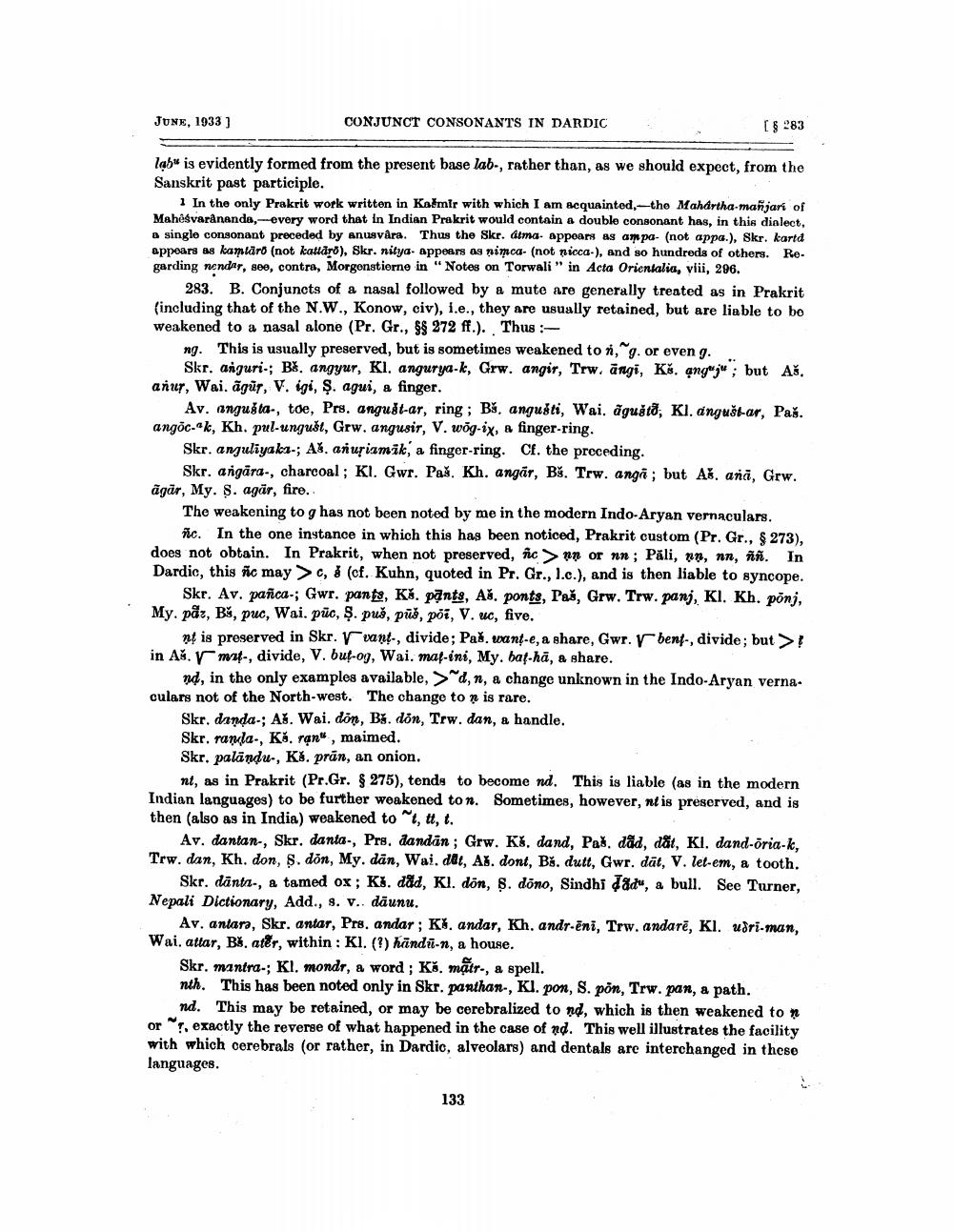________________
JUNE, 1933 ]
CONJUNCT CONSONANTS IN DARDIC
($ 283
lab is evidently formed from the present base lab-, rather than, as we should expect, from the Sanskrit past participle.
In the only Prakrit work written in Kašmir with which I am acquainted, -tho Mahdrtha-manjari of Maheśvarananda,---every word that in Indian Prakrit would contain a double consonant has, in this dialect, a single consonant preceded by anusvåra. Thus the Skr. atma- appears as ampa- (not appa.), Skr. karta appears as kamidro (not katidy), Skr. nitya. appears as nimca. (not nicca.), and so hundreds of others. Regarding nender, 800, contra, Morgonstiorne in "Notes on Torwali" in Acta Orientalia, viii, 296.
283. B. Conjuncts of a nasal followed by a mute are generally treated as in Prakrit (including that of the N.W., Konow, civ), i.e., they are usually retained, but are liable to bo weakened to a nasal alone (Pr. Gr., 88 272 ff.). Thus :
ng. This is usually preserved, but is sometimes weakened to r. . or even g.
Skr. anguri-; BX, angyur, Kl. angurya-k, Grw. angir, Trw. angi, Kg. angeju; but Aš. anur, Wai. āgūr, V. igi, Ş. agui, a finger.
Av. angušta-, toe, Prs, angušt-ar, ring ; Bš, angusti, Wai, ãgušto, Kl. anguštar, Paš. angoc-ok, Kh. pul-ungušt, Grw, angusir, V. wõg-iy, a finger-ring.
Skr. anguliyakı-; AX, anusiamik, a finger-ring. Cf. the preceding.
Skr. angära-, charcoal ; KI. Gwr. Paš. Kh. angār, Bš. Trw. anga; but Ax, ana, Grw. āgār, My. $. agär, fire.
The weakening to g has not been noted by me in the modern Indo-Aryan vernaculars.
ric. In the one instance in which this has been noticed, Prakrit custom (Pr. Gr.. $ 273). does not obtain. In Prakrit, when not preserved, nc>nn or nn; Pāli, an, nn, ññ. In Dardic, this ñc may > , & (cf. Kuhn, quoted in Pr. Gr., 1.c.), and is then liable to syncope.
Skr. Av. pañca-; Gwr. pants, Kš. pants, Aš. ponts, Paš, Grw. Trw. panj, Kl. Kh. ponj, My. pår, Bš, puc, Wai. pūc, $. puš, pūš, poi, V. uc, five.
nt is preserved in Skr. rvant, divide; Paš, want-e, a share, Gwr. r bent, divide; but>! in Agr mit, divide, V. but-og, Wai, map.ini, My. bat-hå, a share.
nd, in the only examples available, >d,n, a change unknown in the Indo-Aryan verna. culars not of the North-west. The change to n is rare.
Skr, danda-: Al. Wai, dón, Bš. dón, Trw. dan, a handle. Skr. randla., K. ran", maimed. Skr. palandu-, Kš. prān, an onion.
nt, as in Prakrit (Pr.Gr. $ 275), tends to become nd. This is liable (as in the modern Indian languages) to be further weakened ton. Sometimes, however, nt is preserved, and is then (also as in India) weakened to , t, t.
Av. dantan.. Skr, danta., Prs, dandan; Grw. K%, dand, Paš, dâd, dät, Kl. dand-oria-k. Trw. dan, Kh. don, s. don, My. dan, Wai, dat, Aš, dont, Bš. dutt, Gwr. dāt, V. let-em, a tooth.
Skr, dantz-, a tamed ox; K3. dåd, Kl. dön, . dono, Sindhi Jadu, a bull. See Turner, Nepali Dictionary, Add., s. v. däunu.
Av. antara, Skr. antar, Prs, andar; K. andar, Kh, andr-ēni, Trw, andarē, kl. udri-man, Wai, attar, Bater, within : Kl. (?) handi-n, a house.
Skr. mantra-; Kl. mondt, a word : K. matr., a spell. nth. This has been noted only in Skr. panthan-, Kl. pon, S. pon, Trw. pan, a path.
nd. This may be retained, or may be cerebralized to nd, which is then weakened ton or !, exactly the reverse of what happened in the case of nd. This well illustrates the facility with which cerebrals (or rather, in Dardio, alveolars) and dentals are interchanged in these languages.
133




